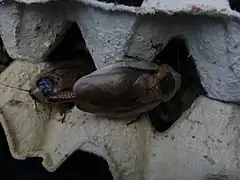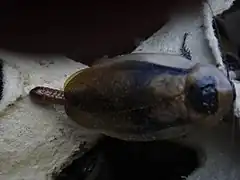| Discoid cockroach | |
|---|---|
 | |
| Scientific classification | |
| Domain: | Eukaryota |
| Kingdom: | Animalia |
| Phylum: | Arthropoda |
| Class: | Insecta |
| Order: | Blattodea |
| Family: | Blaberidae |
| Genus: | Blaberus |
| Species: | B. discoidalis |
| Binomial name | |
| Blaberus discoidalis Audinet-Serville, 1839 | |
| Synonyms | |
| |
Blaberus discoidalis, commonly known as the discoid cockroach,[2] tropical cockroach,[3] West Indian leaf cockroach,[3] false death's head cockroach,[4][5] Haitian cockroach,[6] and drummer,[7] is a cockroach native to Central America of the “giant cockroach” family, Blaberidae.[6][8]
The adult is around 35–45 mm (1.4–1.8 in) in length, and is tan with a dark brown to black patch on its pronotum.[6] The juvenile is brown with tan speckles, and matures to adulthood in 4–5 months.[6] Adults have wings but are not active fliers,[6] and they can not climb smooth vertical surfaces, simplifying their care in captivity.
Blaberus discoidalis is called the false death's head cockroach because of its superficial resemblance to the death's head cockroach, Blaberus craniifer.
Distribution

Blaberus discoidalis is found in Jamaica, Cuba, Hispaniola, Puerto Rico, Puerto Rico (Vieques Island), Panama, Colombia, Venezuela, Trinidad and Tobago, and Florida.[7]
Locomotion
The movement of B. discoidalis runs relatively inefficiently - wasting movement as it runs. It can move about 25 of its body lengths per second, around half the speed of common cockroach Periplaneta americana.[9] In laboratory tests, B. discoidalis cockroaches were adept at obstacle climbing, and maintaining stability with miniature “cannons” strapped to their bodies designed to knock them off balance mid-run.[9] The species served as the basis for the kinematics design of several cockroach-inspired robots.[10][11]
Uses
Pet food
They are very easy to raise in captivity, so make good feed for insectivorous pets such as tarantulas, bearded dragons, and other lizards.
These animals breed readily in captivity. They reach breeding age in about 6 months if kept warm, with 85–90 °F recommended for more productive breeding. Females carry their eggs inside a brooding pouch having genital chamber and vestibulum until they are fertilised by male spermatophore.
Insect eating competitions
Discoid cockroaches are also used in insect eating competitions since they are often raised in captivity and are easier to gather in large numbers during a contest. In 2012, Edward Archibold died as a result of 'asphyxia due to choking and aspiration of gastric contents,' according to his autopsy report, in a cockroach eating contest in south Florida.
Fuel cell
Blaberus discoidalis was used in an experiment to create a miniature fuel cell, producing electricity from naturally occurring sugar in the insect and oxygen in the air.[12] The power density of the species is considered a good design target for small robots.[13]
Image gallery
 Female with ootheca
Female with ootheca Female with ootheca before hatching
Female with ootheca before hatching Mating (male on the left)
Mating (male on the left)
References
- ↑ "Synonyms of Tropical Cockroach (Blaberus discoidalis)". Encyclopedia of Life. Retrieved 27 December 2013.
- ↑ Clopton, Richard E. (2011). "Redescription of Protomagalhaensia granulosae Peregrine, 1970 (Apicomplexa: Eugregarinida: Blabericolidae) Parasitizing the Discoid Cockroach, Blaberus discoidalis (Dictyoptera: Blaberidae)" (PDF). Comparative Parasitology. 78 (1): 63–72. doi:10.1654/4475.1. ISSN 1525-2647. S2CID 30474034.
- 1 2 "Common Names for Tropical Cockroach (Blaberus discoidalis)". Encyclopedia of Life. Retrieved 27 December 2013.
- ↑ Marshall, Samuel D. (2001). Tarantulas and Other Arachnids: Everything about Purchase, Care, Nutrition, Behavior, and Housing. Barron's Educational Series. p. 93. ISBN 978-0-7641-1463-2.
- ↑ "Biofuel cell generates electricity when implanted in false deaths head cockroach (Press release)". ACS News Service. American Chemical Society. 1 February 2012. Retrieved 27 December 2013.
- 1 2 3 4 5 Stockton, Donna. "Husbandry Data Sheet: Haitian cockroaches, Blaberus discoidalis" (PDF). TITAG Husbandry Information. Terrestrial Invertebrate Taxon Advisory Group. Retrieved 27 December 2013.
- 1 2 Beccaloni, GW (2007). "species Blaberus discoidalis Serville, 1838". Blattodea Species File Online. Retrieved 27 December 2013.
- ↑ "ITIS Standard Report Page: Blaberus discoidalis". Integrated Taxonomic Information System. Retrieved 27 December 2013.
- 1 2 Bell, WJ; Roth, LM; Nalepa, CA (2007). Cockroaches: Ecology, Behavior, and Natural History (PDF). JHU Press. pp. 18, 78. ISBN 978-0-8018-8616-4.
- ↑ Pavone, Marco (2005). "Architecture for autonomous robots: adaptive locomotion and distributed covering – Diploma thesis". Scuola Superiore di Catania.
{{cite journal}}: Cite journal requires|journal=(help) - ↑ Bekey, George A. (2005). Autonomous Robots: From Biological Inspiration to Implementation and Control. MIT Press. p. 293. ISBN 978-0-262-02578-2.
- ↑ Rasmussen, Michelle; Ritzmann, Roy E.; Lee, Irene; Pollack, Alan J.; Scherson, Daniel (2012). "An Implantable Biofuel Cell for a Live Insect". Journal of the American Chemical Society. 134 (3): 1458–1460. doi:10.1021/ja210794c. ISSN 0002-7863. PMID 22239249.
- ↑ Steltz, Erik Edward (2008). Redesign of the Micromechanical Flying Insect in a Power Density Context. p. 10. ISBN 978-0-549-83412-0.